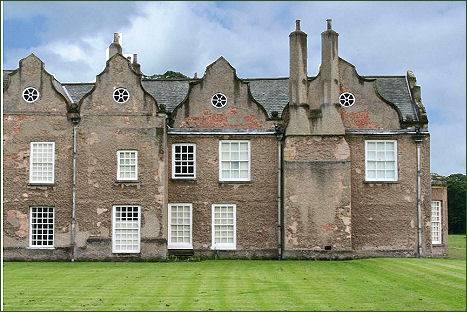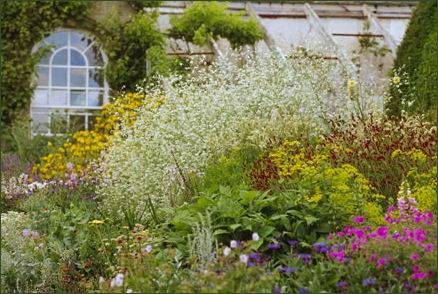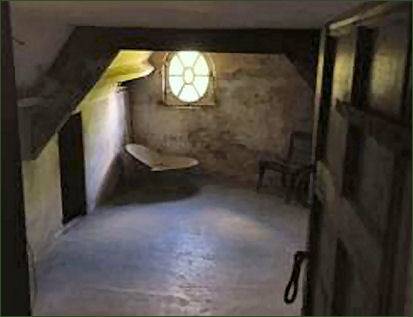Norton Conyers
OS grid reference:- SE 319 761
 Norton Conyers House, situated in Wensleydale, some 4 miles (7 km) to the north of the town of Ripon,
is a late medieval manor house with additions from the Stuart and Georgian periods.
Norton Conyers House, situated in Wensleydale, some 4 miles (7 km) to the north of the town of Ripon,
is a late medieval manor house with additions from the Stuart and Georgian periods.
The frontage has distinctive Dutch-style gables, while the interior contains some fine eighteenth century plaster ceilings in the principal rooms, china, constumes and a noteable collection of family portraits and a famous John Ferneley hunting group, 'The Quorn Hunt in 1822'.
The house has an eighteenth century garden, a gravel path, running between colourful herbaceous borders flanked by tall yew hedges, leads up to an orangery, which is open to visitors..
Norton Conyers was visited by King Charles I in 1633 and by King James II (while Duke of York) and his wife Mary of Modena in 1679, while en route to Scotland, the room and the bed they are reputed to have used are still on display.
The manor of Norton Conyers once belonged to Richard Norton, known as "Old Norton", who, along with his son Christopher, was executed in 1569 for his part in the Rising of the North, a Catholic rebellion in the reign of Queen Elizabeth I.
 Norton had received a pardon for taking part in the Pilgrimage of Grace, but he along with his brother Thomas, and his nine sons, enthusiastically joined the northern uprising of the Percy Earl of Northumberland and Neville, Earl of Westmorland, aimed at restoring Catholicism to England. The story is related by Wordsworth in his epic poem, "The Whyte Doe of Rhysdale".
Norton had received a pardon for taking part in the Pilgrimage of Grace, but he along with his brother Thomas, and his nine sons, enthusiastically joined the northern uprising of the Percy Earl of Northumberland and Neville, Earl of Westmorland, aimed at restoring Catholicism to England. The story is related by Wordsworth in his epic poem, "The Whyte Doe of Rhysdale".
After briefly being held by the Musgrave family, Norton Conyers was acquired by Sir Richard Graham in 1624 and, except for 20 years between 1862 and 1882, has remained in the Graham family ever since. The Graham family moved from Scotland to the English borders in the sixteenth century, where they acquired a reputation for turbulence and cattle-stealing. In the early seventeenth century, however, Richard Graham, a younger son of the family, went to London and entered the service of George Villiers, Duke of Buckingham, a favourite of King James I. He acquired the position of the Duke's Master of the Horse, going on to become one of King Charles I's Gentleman of the Horse and eventually the owner of two estates, Norton Conyers in Yorkshire and Netherby in Cumbria.
Sir Richard Graham died at Norton Conyers in 1644 of wounds received at the Civil War battle of Marston Moor, soon after fleeing to his home following the Royalist defeat he arrived at Norton Conyers bleeding badly from numerous wounds and died that night. The Graham Baronetcy, of Norton Conyers was created in 1662 for his son Richard Graham in honour of his services at the Restoration of the Monarchy. The house is now owned by Sir James and Lady Graham
Charlotte Bronte, the Attic Room and 'Jane Eyre'
 Charlotte Brontė visited Norton Conyers in 1839 when she was employed as a governess to a family called the Sidgwicks. The legend of a mad woman who was confined in the attic in the previous century is said to have provided the inspiration for the mad Mrs Rochester in her novel 'Jane Eyre'.
Charlotte Brontė visited Norton Conyers in 1839 when she was employed as a governess to a family called the Sidgwicks. The legend of a mad woman who was confined in the attic in the previous century is said to have provided the inspiration for the mad Mrs Rochester in her novel 'Jane Eyre'.
The house closely fits Charlotte Bronte's description of 'Thornfield Hall' "three storeys high, of proportions not vast, though considerable, a gentleman's manor house, not a nobleman's seat". Both houses have battlements, a rookery, a sunken fence and wide main oak staircase.
The discovery in 2004 of a secret blocked staircase connecting the first floor to the attics which are mentioned in the novel, evoked worldwide press interest. Wood panelling on the first floor, which was believed to have been fitted in the 1880's, concealed a hidden door which led to a narrow cramped staircase up to the attic, where, through a warren of corridors lies the "Mad Woman's room".
In the novel the mentally ill Bertha Mason is locked in the attic for ten years by her husband Edward Rochester before she escaped, set the house ablaze and threw herself off the roof. The door on the landing outside the Peacock Room leading to what was once known as 'Mad Mary's Room' would have been clearly visible at the time Charlotte Brontė's visit.
Historic Buildings of Yorkshire
